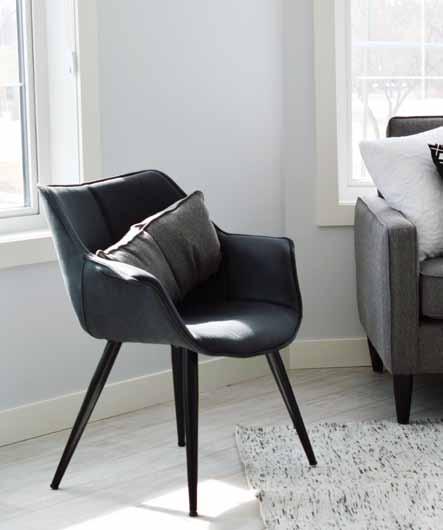
7 minute read
Transform a Space
trAnsform A spAcE in fivE simpLE stEps JULiE BArnEs
As the owner and principal designer of Vivid Interior Designs, Jocelyn Malcolm is often asked to speak to Saskatoon high school students about her chosen career path. Those speaking opportunities sparked an interest in distilling some of the fundamentals of interior decorating into an online course. Design Your Room in Five Simple Steps is tailored to both aspiring designers and anyone just interested in a bit of DIY.
Advertisement
Saskatoon HOME recently chatted with Jocelyn to learn how anyone can implement these steps to transform their own space. Although her course focuses on designing a bedroom, the steps can be applied to any room of your home.
1. Inspiration and visualization
One of the first steps for gathering inspiration is to take a look at your closet, says Jocelyn. “If we buy it, wear it and love it, it has to say something about us.” She suggests taking a close look at some of favourite pieces, and asking ourselves what it is about the item that we’re drawn to.
“I also think you can look around your house and pull things from your own space that you really love… it’s important to gather from what you truly feel is your own personal style,” she says. “If you love your bedding and don’t want to change it, that might help create your colour palette.”
Then it’s time to venture outside. “Go out into nature and look around your city and gather materials,” she says. “Take pictures and gather inspirational photos from your own neighbourhood.” In Saskatoon, Jocelyn says inspiration can be found anywhere from the river valley trails, to

“Everyone has a good and bad association with colour,” says Jocelyn. For some people, blue bedroom walls might be calming, while for others, it could evoke sadness. vibrant street art, to modern architecture. “Gather inspiration outside of your computer,” she says.
Digital inspiration sources like Pinterest, Houzz and Instagram are still great tools, but Jocelyn recommends paring down online inspiration photos to 10 images to avoid becoming overwhelmed.

2. Colour Psychology and mood
The psychological effect colour has on us is often underestimated, or completely overlooked, when it comes to designing our own spaces, says Jocelyn.
“Everyone has a good and bad association with different colours,” she says. “As a designer, I feel the trick with finding the right colour for a client is to find the best psychological association with colour.”
For Jocelyn, that involves interviewing her clients to determine what kind of visceral reactions they experience with different colours. For example, some
Colour is a powerful tool, so Jocelyn interviews her clients to determine what kind of visceral reactions they experience to various colours before embarking on a design.
Think about the items you want to bring into your space that are practical, comforable or both.

Furniture | Décor | Women’s Apparel

clients may have a positive association with the colour red—it may evoke feelings of love, power or passion, says Jocelyn. In others, it may provoke a negative association, like anger.
“When you want to add red to a room, that might mean you are feeling bold or you have confidence, so that might be something you want to bring attention to,” she says. But if you associate red with anger, you’ll want to steer away from it.
Similarly, blue can evoke calmness in some people, while others may find it conjures sadness. “The only colour that doesn’t have a strong negative association is pink,” says Jocelyn. “It’s seen as calmness, kindness—a nurturing feeling.”
Jocelyn often brings the colour orange into her commercial designs, as it can be associated with “energetic, enthusiastic communication…you choose different colours or accents based on what kind of feeling you want to have in that room,” she says. That said, orange might feel too bold for someone looking for a calming atmosphere in a bedroom.
3. Comfort and Practicality
The third step is about determining your wants and needs, says Jocelyn. For example, dimmable reading lights might be something you want for your bedroom, while a bed is a practical item you’ll need. Jocelyn says it’s important to balance the need to “be imaginative in creating a room that’s unique to you and your style” while still being functional, and maintaining longevity.
Comfort considerations in designing a bedroom might include whether you want a separate reading area, whether you need blackout blinds or prefer to be roused by the sun, and whether or not you want something soft underfoot when you get up in the morning.
Affordable and sustainable style. Redefining how you shop.
Shop online or in-store. New products coming in regularly.

@juniperandoak @juniperandoakconsignment 2642 Millar Ave | 306-933-2727
New Consignments Added to Our Website Often! www.juniperandoak.ca

A mood board created by Jocelyn shows the colours and textures planned for her space.
4. From Scratch to Sketch
“You want to get out a ruler and start sketching” at this stage, says Jocelyn. “This is where the basics of designing came from.” Although many designers use computer software, sketching is still an important skill to learn, she adds.
“Some people are very visual,” Jocelyn says. If you have an idea of a chandelier you’d like for your bedroom, putting that design down on paper helps because it’s easier to source something when you have a clear idea of what you’re looking for.
Think about the layers of your room—lighting, furniture, fabrics, decor, accessories, art and room layout.
Creating a mood board is another great way to visualize how your materials will work together. You can use a mood board to pull together your selected finishing materials—such as tiles, paint swatches, knobs, fabrics and flooring.
“This is a key tool for shopping for your space,” says Jocelyn. She often creates mood boards for her clients to reference. If, down the road, they want to add some accent pillows to their bedroom, they’ll bring their mood board with them when they go shopping to ensure they choose shades that work with their existing colour palette.
“There may be a teal colour in 14 different tones and you could get that wrong if you don’t have the actual board with you to choose the décor.”

A mood board for this living room could include paint swatches for the wall and baseboard colours, a flooring sample and a swatch of the upholstery fabric. It becomes a helpful tool when shopping for accents or updating furniture.
Even with today’s CAD programs, sketching is still an important skill to learn, says Jocelyn.


5. layout and Design 101
The fifth and final step introduces 3D rendering software called ‘Homestyler,’ which offers a free basic version. “You plug your room measurements into the program and it will create a 3D version of your room,” says Jocelyn.
Then you can add doors and windows, select your flooring, paint colours and wallpaper, and select furniture and accent pieces from over 200 real furniture brands. The software creates both a bird’s eye view of your room, and a 3D walkthrough view.
The software also “creates a shopping list once you’ve designed your room, based on the items you put in your space,” says Jocelyn. “That’s a cool feature I don’t see very often.”
Jocelyn adds that the software is user-friendly— whether you’re using it as a newbie designer, or just want to DIY. It’s for all skill levels, just like her online course.
Whether someone is starting out to design a full house or just decorate one room, Jocelyn says she hopes people who learn these five steps will “walk away creatively inspired” with “a greater understanding of the design process, tools and fundamentals required to make their spaces unique and beautiful.”
Julie Barnes Proudly Building Solid Custom Homes for Over 13 Years

With SilverStone, you will work directly with the owner on your project from start to finish. You can expect trust, quality, and exceptional communication.

Bill Kellins, Owner & Construction Lead
LocaL home buiLDer The Difference is in the Details
Visit our website, or call to set up a no-pressure meeting to speak about your project today. www.silverstonedevelopments.com 306-260-3100
Proudly Celebrating Years in Business 21
www.cadvantagedesign.com
CuStom Home/CABin DeSign ADDitionS & RenovAtionS 3D LASeR SCAnning (AS-BuiLtS) LigHt CommeRCiAL Building Design Drafting services
Phone: (306) 373-3805 #110 - 4002 Arthur Rose Ave, Saskatoon






